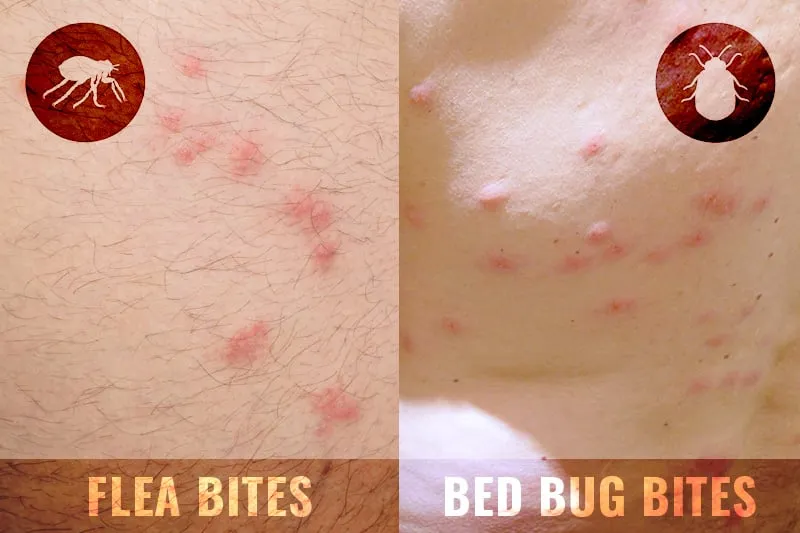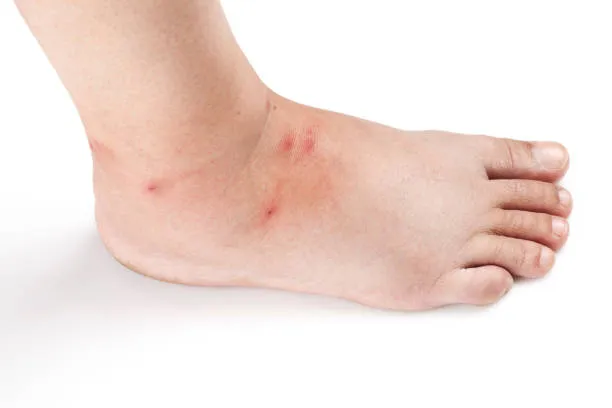Waking up with itchy bumps on your skin can be unsettling, leaving you wondering what pesky insect might be the culprit. Both fleas and bed bugs are notorious for leaving itchy bites, but there are key differences between the two. Understanding these distinctions can help you identify the source of your bites and take the necessary steps to address the infestation.
Table of Contents
ToggleFlea Bites: Characteristics and Clues
Appearance:
- Small, red bumps, often with a single puncture point in the center
- May appear in clusters of two or three bites, forming a straight line or zig-zag pattern
Location:
- Primarily found on lower legs, ankles, and feet, areas easily accessible when you’re standing or sitting
- Can also appear on arms, elbows, and knees, especially if you spend time on the floor
Symptoms:
- Intense itching and irritation
- Bites may form small blisters if scratched excessively
Additional Clues:
- Presence of fleas on your pets or in your home (tiny, brown, jumping insects)
- Recent pet infestation or contact with other animals
Bed Bug Bites: Characteristics and Clues
Appearance:
- Small, red bumps, similar to mosquito bites
- May appear in a straight line, cluster, or row, often following the seams of bedding
Location:
- Primarily found on exposed areas of skin while you sleep, such as the face, neck, arms, shoulders, and back
- Bites may also appear on legs if the infestation is severe
Symptoms:
- Itching, ranging from mild to severe
- Bites may develop a crust if scratched
Additional Clues:
- Rusty brown stains on bedding or furniture from crushed bed bugs
- Tiny, black fecal spots on mattresses, bed frames, or baseboards
- A musty odor in the bedroom
Table: Comparing Flea Bites and Bed Bug Bites
| Feature | Flea Bites | Bed Bug Bites |
|---|---|---|
| Appearance | Small red bumps, single puncture point | Small red bumps, may appear in a line |
| Location | Lower legs, ankles, feet, arms, elbows, knees | Exposed skin while sleeping (face, neck, arms, shoulders, back) |
| Pattern | Clusters of 2-3 bites, zig-zag lines | Straight line, cluster, or row |
| Symptoms | Itching may crust over | Itching, may crust over |
| Additional Clues | Fleas on pets, recent pet infestation | Rusty stains, fecal spots, musty odor |

drive_spreadsheetExport to Sheets
FAQs: Understanding Fleas and Bed Bugs
Q: Can I differentiate flea bites from bed bug bites based solely on appearance?
A: While the appearance of individual bites can be similar, the location and pattern of bites are more reliable indicators. Flea bites typically appear in clusters on the lower body, while bed bug bites often follow a line or cluster on exposed skin while sleeping.
Q: Are flea bites and bed bug bites dangerous?
A: While neither is usually life-threatening, both can cause itching, discomfort, and potential allergic reactions. Additionally, flea bites can transmit diseases like tapeworm in rare cases, and bed bug bites can lead to anxiety and sleep disturbances due to their persistent nature.
Q: How do I treat flea bites and bed bug bites?
A: Both can be treated with over-the-counter anti-itch creams and calamine lotion to soothe the itching. However, addressing the source of the infestation is crucial. For fleas, treat your pets with appropriate medications and thoroughly clean your home. For bed bugs, professional pest control is often necessary due to their rapid reproduction and hiding ability.
Q: How can I prevent flea and bed bug bites?
- Fleas: Regularly treat your pets with flea medication, vacuum carpets, and furniture frequently, wash pet bedding in hot water, and prevent pets from jumping on furniture.
- Bed bugs: Regularly inspect mattresses, box springs, and furniture for signs of bed bugs, encase mattresses and box springs in special covers, and seal any cracks or crevices where bed bugs might hide.
Beyond the Basics: Delving Deeper into Flea Bites vs. Bed Bug Bites
While the previous section provided a good overview, understanding the nuances of flea bites and bed bug bites can be immensely helpful. Here’s a deeper dive into each type of bite, including additional information and insights:
Flea Bites:
- Transmission: Fleas primarily live on animals, especially cats and dogs. They can jump onto humans and feed on their blood, leaving bites in the process. Humans are not their preferred host, and bites typically occur when people come into contact with infested pets or areas frequented by animals.
- Life Cycle: Fleas have a four-stage life cycle: egg, larva, pupa, and adult. Eggs are often laid on pets, carpets, and bedding. Larvae thrive in warm, humid environments and feed on organic debris. Pupae develop in cocoons, and adult fleas emerge to feed on blood. Addressing all stages is crucial for complete eradication.
- Complications: While rare, flea bites can transmit diseases like murine typhus and tapeworm to humans, particularly children who may accidentally ingest fleas.
- Treatment: Aside from over-the-counter anti-itch remedies, treating the underlying flea infestation is essential. This involves:
- Treating your pets with veterinarian-recommended flea medication.
- Thoroughly cleaning your home: Vacuum carpets, furniture, and pet bedding frequently, paying close attention to crevices and corners. Wash bedding, curtains, and stuffed toys in hot water (at least 130°F).
- Treating your yard (if applicable) with flea control products according to the manufacturer’s instructions.
Bed Bug Bites:
- Feeding Habits: Unlike fleas, bed bugs are obligate blood feeders, meaning they solely rely on human blood for survival. They are nocturnal insects, feeding on exposed skin while people sleep.
- Hiding Spots: Bed bugs are excellent hiders and prefer dark, secluded areas near their food source (humans). They often reside in mattresses, box springs, bed frames, headboards, and furniture seams.
- Signs of Infestation: In addition to bites, other signs of bed bugs include:
- Rusty brown stains on bedding or furniture from crushed bed bugs.
- Tiny, black fecal spots on mattresses, bed frames, or baseboards.
- A musty odor in the bedroom, often described as smelling like “wet laundry” or “berries.”
- Treatment: Due to their complex life cycle and hiding behavior, professional pest control is usually recommended for bed bug infestations. They employ various methods, including insecticides, heat treatments, and cryotherapy to eliminate all stages of the bugs.
Additional Tips:
- Early detection is key: Regularly inspect your mattress, box spring, and furniture for signs of bed bugs or flea activity.
- Preventative measures: Encase mattresses and box springs in protective covers to prevent bed bugs from hiding and feeding. Vacuuming regularly and washing bedding in hot water can help deter both fleas and bed bugs.
- Seek professional help in case of doubt: If you suspect a flea or bed bug infestation, consult a pest control professional for proper identification and treatment strategies.
By understanding the distinct characteristics, life cycles, and treatment options for flea bites and bed bug bites, you can effectively address these pesky problems and ensure a pest-free environment for yourself and your loved ones.

Conclusion
While both flea bites and bed bug bites can be bothersome, understanding their distinguishing features and taking appropriate action can help you quickly address the problem and regain peace of mind. If you suspect a flea or bed bug infestation, consult with a pest control professional for effective treatment and prevent further bites. Remember, early detection and intervention are key to eliminating these pesky insects from your home.












